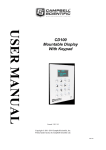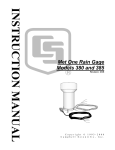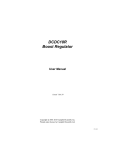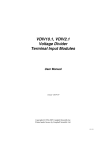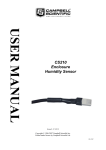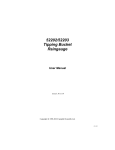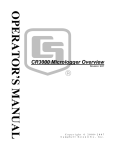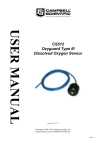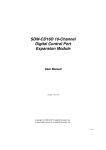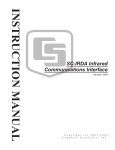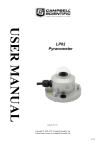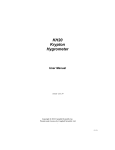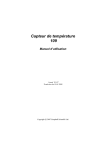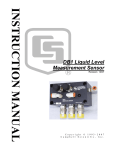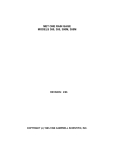Download 3WHB10K 3-Wire Half Bridge Terminal Input
Transcript
3WHB10K 3-Wire Half Bridge Terminal Input Module User Manual Issued 19.9.07 Copyright © 1996-2007 Campbell Scientific Inc. Printed under licence by Campbell Scientific Ltd. CSL341 Guarantee This equipment is guaranteed against defects in materials and workmanship. This guarantee applies for twelve months from date of delivery. We will repair or replace products which prove to be defective during the guarantee period provided they are returned to us prepaid. The guarantee will not apply to: • Equipment which has been modified or altered in any way without the written permission of Campbell Scientific • Batteries • Any product which has been subjected to misuse, neglect, acts of God or damage in transit. Campbell Scientific will return guaranteed equipment by surface carrier prepaid. Campbell Scientific will not reimburse the claimant for costs incurred in removing and/or reinstalling equipment. This guarantee and the Company’s obligation thereunder is in lieu of all other guarantees, expressed or implied, including those of suitability and fitness for a particular purpose. Campbell Scientific is not liable for consequential damage. Please inform us before returning equipment and obtain a Repair Reference Number whether the repair is under guarantee or not. Please state the faults as clearly as possible, and if the product is out of the guarantee period it should be accompanied by a purchase order. Quotations for repairs can be given on request. When returning equipment, the Repair Reference Number must be clearly marked on the outside of the package. Note that goods sent air freight are subject to Customs clearance fees which Campbell Scientific will charge to customers. In many cases, these charges are greater than the cost of the repair. Campbell Scientific Ltd, Campbell Park, 80 Hathern Road, Shepshed, Loughborough, LE12 9GX, UK Tel: +44 (0) 1509 601141 Fax: +44 (0) 1509 601091 Email: [email protected] www.campbellsci.co.uk Contents PDF viewers note: These page numbers refer to the printed version of this document. Use the Adobe Acrobat® bookmarks tab for links to specific sections. 1. Function ....................................................................... 1 2. Specifications .............................................................. 1 3. Wiring ........................................................................... 2 4. Programming Examples ............................................. 2 4.1 4.2 4.3 4.4 4.5 CR9000X ..................................................................................................3 CR1000.....................................................................................................3 CR10(X) ...................................................................................................4 21X ...........................................................................................................4 CR7...........................................................................................................5 5. 100 Ohm PRT in 3-Wire Half Bridge ........................... 5 5.1 Excitation Voltage ....................................................................................5 5.2 Calibrating a PRT .....................................................................................6 5.3 Compensation for Wire Resistance...........................................................6 Figures 1-1. Terminal Input Module ...........................................................................1 2-1. Schematic ................................................................................................1 3-1. 3-Wire Half Bridge Used to Measure PRT .............................................2 Tables 3-1. 3WHB10K Connections to Campbell Scientific Dataloggers.................2 4-1. Excitation Voltage for 100 Ohm PRT in 3WHB10K Based on Maximum Temperature and Input Voltage Range...............................3 i This is a blank page. 3WHB10K 3-Wire Half Bridge Terminal Input Module 1. Function Terminal input modules connect directly to the datalogger's input terminals to provide completion resistors for resistive bridge measurements, voltage dividers, and precision current shunts. H L G H L AG H L AG Figure 1-1. Terminal Input Module 2. Specifications 10 kOhm Completion Resistor Tolerance @ 25°C Temperature coefficient 0°-60°C -55°-125°C Power rating @ 70°C ±0.01% ±4 ppm/°C ±8 ppm/°C 0.25 W Vx 10 kΩ H H L L or AG G Figure 2-1. Schematic 1 3WHB10K 3-Wire Half Bridge Terminal Input Module 3. Wiring Datalogger Vx 10 kΩ H H L L or AG G or G A B Shield Figure 3-1. 3-Wire Half Bridge Used to Measure PRT Table 3-1. 3WHB10K Connections to Campbell Scientific Dataloggers Function Label/Lead CR10X, CR510 Excitation V1 Reference V2 Sense Ground Black Wire H L G E1 SE1 SE2 AG CR23X, CR1000, CR800, CR850, CR3000 EX1 SE1 SE2 21X, CR7, CR9000X Excitation 1 1H 1L 4. Programming Examples The following examples simply show the two instructions necessary to 1) make the measurement and 2) calculate the temperature. The result of the 3-wire half bridge measurement as shown is Rs/Ro, the input required for the PRT algorithm to calculate temperature. All the examples are for a 100 Ohm PRT in the 3WHB10K. The excitation voltages used were chosen with the assumption that the temperature would not exceed 50°C. Table 4-1 lists excitation voltage as a function of maximum temperature and the input voltage ranges used with the different dataloggers. Calculation of optimum excitation voltage is discussed in Section 5.1. The multiplier shown is for a 100 Ohm PRT. The multiplier for a 1000 Ohm PRT is 10. 2 User Manual Table 4-1. Excitation Voltage for 100 Ohm PRT in 3WHB10K Based on Maximum Temperature and Input Voltage Range Max. Temp °C 50 100 150 200 250 300 350 400 450 500 550 600 650 700 750 800 850 PRT Resistance Ohms 119.4 138.5 157.31 175.84 194.07 212.02 229.67 247.04 264.11 280.9 297.39 313.59 329.51 345.13 360.47 375.51 390.26 Excitation Voltage, mV ±25 mV Input ±50 mV Range, Range, CR10(X), 21X, CR7, CR800, CR850, CR3000, CR1000, CR9000X 2119 4237 1830 3660 1614 3228 1447 2893 1313 2626 1204 2408 1113 2227 1037 2074 971 1943 915 1830 866 1731 822 1644 784 1567 749 1499 718 1437 691 1381 666 1331 4.1 CR9000X 'CR9000X Datalogger Public RS_Ro, Temp_F DataTable (Temp_F,1,-1) DataInterval (0,0,0.10) Sample (1,Temp_F,FP2) EndTable BeginProg Scan (1,mSec,0,0) BrHalf3W (Rs_Ro,1,V50,5,1,6,1,1,4200,True,30,40,100,0) PRT (Temp_F,1,Rs_Ro,1.8,32) CallTable Temp_F NextScan EndProg 4.2 CR1000 'CR1000 Series Datalogger Public Rs_R0, Temp_C DataTable (Hourly,True,-1) DataInterval (0,60,Min,0) 3 3WHB10K 3-Wire Half Bridge Terminal Input Module Average (1,Temp_C,IEEE4,0) EndTable BeginProg Scan (1,Sec,0,0) BrHalf3W (Rs_R0,1,mV25,1,Vx1,1,2100,True ,0,250,100,0) PRT (Temp_C,1,Rs_R0,1.0,0) CallTable Hourly NextScan EndProg 4.3 CR10(X) 1: 3W Half Bridge (P7) 1: 1 Reps 2: 23 ± 25 mV 60 Hz Rejection Range 3: 1 SE Channel 4: 1 Excite all reps w/Exchan 1 5: 2100 mV Excitation 6: 1 Loc [ Rs_R0 ] 7: 100 Mult 8: 0 Offset 2: Temperature RTD (P16) 1: 1 Reps 2: 1 R/RO Loc [ Rs_R0 3: 2 Loc [ Temp_C ] 4: 1.0 Mult 5: 0.0 Offset ] 4.4 21X 1: 3W Half Bridge (P7) 1: 1 Reps 2: 3 ± 50 mV Slow Range 3: 1 SE Channel 4: 1 Excite all reps w/Exchan 1 5: 4200 mV Excitation 6: 1 Loc [ Rs_R0 ] 7: 100 Mult 8: 0 Offset 2: Temperature RTD (P16) 1: 1 Reps 2: 1 R/RO Loc [ Rs_R0 3: 2 Loc [ Temp_C ] 4: 1.0 Mult 5: 0 Offset 4 ] User Manual 4.5 CR7 1: 3-Wire Half Bridge (P7) 1: 1 Reps 2: 4 ± 50 mV Slow Range 3: 1 In Card 4: 1 SE Channel 5: 1 Ex Card 6: 1 Ex Channel 7: 1 Meas/Ex 8: 4200 mV Excitation 9: 1 Loc [ Rs_R0 ] 10: 100 Mult 11: 0 Offset 2: Temperature RTD (P16) 1: 1 Reps 2: 1 R/RO Loc [ Rs_R0 3: 2 Loc [ Temp_C ] 4: 1 Mult 5: 0 Offset ] 5. 100 Ohm PRT in 3-Wire Half Bridge The advantages of the 3-wire half bridge over other measurements that correct for lead wire resistance such as a 4-wire half bridge, are that it only requires 3 lead wires going to the sensor and takes 2 single-ended input channels, whereas the 4-wire half bridge requires 4 wires and 2 differential channels. The result of the 3-wire half bridge instruction is equivalent to the ratio of the PRT resistance, Rs to the resistance of the 10 k fixed resistor, Rf. Rs Rf The RTD Instruction (16) computes the temperature (°C) for a DIN 43760 standard PRT from the ratio of the PRT resistance at the temperature being measured (Rs) to its resistance at 0°C (R0). Thus, a multiplier of Rf/R0 is used with the 3-wire half bridge instruction to obtain the desired intermediate, Rs/R0 = (Rs/Rf x Rf/Ro). When Rf = 10,000 and R0 = 100, the multiplier is 100; when R0 is 1000 the multiplier is 10. The fixed resistor must be thermally stable. Over the -55° to 85°C extended temperature range for the datalogger, the ±4 ppm/°C temperature coefficient would result in a maximum error of ±0.04°C at 60°C. The ±8 ppm/°C temperature coefficient would result in a maximum error of ±0.13°C at -55°C. 5.1 Excitation Voltage The best resolution is obtained when the excitation voltage is large enough to cause the signal voltage to fill the measurement voltage range. The voltage drop across the PRT is equal to the current, I, multiplied by the resistance of the PRT, Rs, and is greatest when Rs is greatest. For example, if it is desired to measure a temperature in the range of -10 to 40°C, the maximum voltage drop will be at 40°C when Rs = 115.54 Ohms. To find the maximum excitation voltage that can 5 3WHB10K 3-Wire Half Bridge Terminal Input Module be used when the measurement range is ±25 mV, we assume V2 equal to 25 mV and use Ohm's Law to solve for the resulting current, I. I = 25 mV/Rs = 25 mV/115.54 Ohms = 0.216 mA Vx is equal to I multiplied by the total resistance: Vx = I(Rs+Rf) = 2.18 V If the actual resistances were the nominal values, the 25 mV range would not be exceeded with Vx = 2.18 V. To allow for the tolerances in the actual resistances and to leave a little room for higher temperatures, set Vx equal to 2.1 volts. 5.2 Calibrating a PRT The greatest source of error in a PRT is likely to be that the resistance at 0°C deviates from the nominal value. Calibrating the PRT in an ice bath can correct this offset and any offset in the fixed resistor in the Terminal Input Module. With the PRT at 0°C, Rs = R0. Thus, the above result becomes R0/Rf, the reciprocal of the multiplier required to calculate temperature, Rf/R0. By making a measurement with the PRT in an ice bath, errors in both Rs and R0 can be accounted for. To perform the calibration, connect the PRT to the datalogger and program the datalogger to measure the PRT with the 3-wire half bridge as shown in the example section. For a 100 Ohm PRT use a multiplier of 100; for a 1000 Ohm PRT use a multiplier of 10. Place the PRT in an ice bath (@ 0°C; Rs = R0). Read the result of the bridge measurement. The reading is Rs/Rf, which is equal to R0/Rf since Rs = R0. The correct value of the multiplier, Rf/R0, is the multiplier used divided by this reading. For example, if, with a 100 Ohm PRT, the initial reading is 0.9890, the correct multiplier is: Rf/R0 = 100/0.9890 = 101.11. 5.3 Compensation for Wire Resistance The 3-wire half bridge compensates for lead wire resistance by assuming that the resistance of wire A is the same as the resistance of wire B (Figure 3-1). The maximum difference expected in wire resistance is 2%, but is more likely to be on the order of 1%. The resistance of Rs calculated with Instruction 7, is actually Rs plus the difference in resistance of wires A and B. For example, assume that a 100 Ohm PRT is separated from the datalogger by 500 feet of 22 awg wires. The average resistance of 22 AWG wire is 16.5 Ohms per 1000 feet, which would give each 500 foot lead wire a nominal resistance of 8.3 Ohms. Two percent of 8.3 Ohms is 0.17 Ohms. Assuming that the greater resistance is in wire B, the resistance measured for the PRT (R0 = 100 Ohms) in the ice bath would be 100.17 Ohms, and the resistance at 40°C would be 115.71. The measured ratio Rs/R0 is 1.1551; the actual ratio is 115.54/100 = 1.1554. The temperature computed by Instruction 16 from the measured ratio would be about 0.1°C lower than the actual temperature of the PRT. This source of error does not exist in a 4-wire half bridge where a differential measurement is used to directly measure the voltage across the PRT. 6 CAMPBELL SCIENTIFIC COMPANIES Campbell Scientific, Inc. (CSI) 815 West 1800 North Logan, Utah 84321 UNITED STATES www.campbellsci.com [email protected] Campbell Scientific Africa Pty. Ltd. (CSAf) PO Box 2450 Somerset West 7129 SOUTH AFRICA www.csafrica.co.za [email protected] Campbell Scientific Australia Pty. Ltd. (CSA) PO Box 444 Thuringowa Central QLD 4812 AUSTRALIA www.campbellsci.com.au [email protected] Campbell Scientific do Brazil Ltda. (CSB) Rua Luisa Crapsi Orsi, 15 Butantã CEP: 005543-000 São Paulo SP BRAZIL www.campbellsci.com.br [email protected] Campbell Scientific Canada Corp. (CSC) 11564 - 149th Street NW Edmonton, Alberta T5M 1W7 CANADA www.campbellsci.ca [email protected] Campbell Scientific Ltd. (CSL) Campbell Park 80 Hathern Road Shepshed, Loughborough LE12 9GX UNITED KINGDOM www.campbellsci.co.uk [email protected] Campbell Scientific Ltd. (France) Miniparc du Verger - Bat. H 1, rue de Terre Neuve - Les Ulis 91967 COURTABOEUF CEDEX FRANCE www.campbellsci.fr [email protected] Campbell Scientific Spain, S. L. Psg. Font 14, local 8 08013 Barcelona SPAIN www.campbellsci.es [email protected] Campbell Scientific Ltd. (Germany) Fahrenheitstrasse13, D-28359 Bremen GERMANY www.campbellsci.de [email protected] Please visit www.campbellsci.com to obtain contact information for your local US or International representative.














